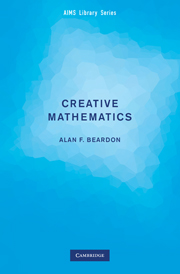Preface
Published online by Cambridge University Press: 16 May 2024
Summary
This text is written to help readers experience the joy of creating their own mathematics. At its simplest level, the first half of the text can be read by students at school; the second half contains, or at least suggests, material at graduate level and beyond. The aim is to provide guidance (rather than instructions) for readers who are expected to be actively involved in attempting to solve the wide variety of problems in the text.
Part I consists of three essays: on solving problems, on writing mathematics, and on giving a presentation. These express the author's personal views, developed over many years, and it is hoped that the reader may find something new and useful in these.
The rest of the book contains a variety of problems, hints, generalisations and (sometimes partial) solutions. In more detail, this part, and indeed each problem, is organised as follows:
In Part II Some elementary problems are introduced, sometimes with suggestions for investigations.
In Part III The likely results of the investigations are discussed, and the problem is solved (usually in an elementary way). Possible generalisations of the problem are suggested, and directions for further investigations are given.
In Part IV Solutions of some of the generalisations are given, and yet more problems are raised. At this point, there may still be a substantial investigation ahead.
This is not a text about solving conventional problems. As the title suggests, it is about solving problems in the sense of doing research. Perhaps themain difference between these two views is that in research, as in this text, obtaining a prescribed answer is not the primary aim; the aim is reach some conclusion and, if necessary, we should be prepared to change the problem in order to reach a conclusion. The objective is to use mathematics as best we can to understand a situation, and variations of it. The emphasis is on understanding the applications of mathematics, and not on finding the answer.
The problems in this book were developed over several years in a course on Problem Solving given by the author at the African Institute for Mathematical Sciences at Muizenberg, South Africa. The Institute was first opened in September, 2003, and it takes graduate students from all over Africa.
- Type
- Chapter
- Information
- Creative MathematicsA Gateway to Research, pp. ix - xPublisher: Cambridge University PressPrint publication year: 2009

